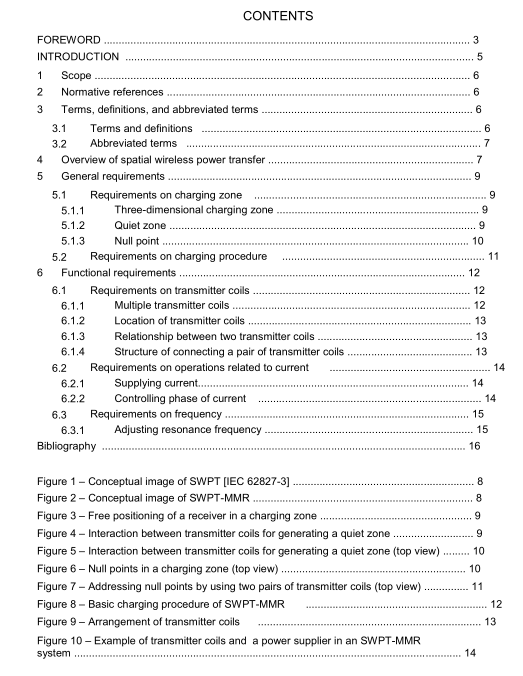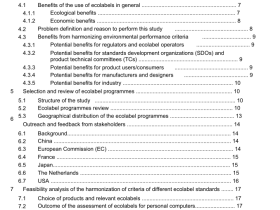IEC 63245-1 pdf – Spatial wireless power transfer based on multiple magnetic resonances – Part 1: Requirements

IEC 63245-1 pdf – Spatial wireless power transfer based on multiple magnetic resonances – Part 1: Requirements
1Scope
This part of lEC 63245 specifies requirements for spatial wireless power transfer based onmultiple magnetic resonances (SWPT-MMR), which is’a non-radiative wireless power transfer(WPT). This document contains two categories of requirements: general requirements andfunctional requirements. The general requirements cover charging procedures and chargingzones.The functional requirements covereach component of asWPT-MMR system, suchastransmitter coils.
2 Normative references
There are no normative references in this document.
3Terms,definitions,and abbreviated terms
For the purposes of this document, the following terms and definitions apply.
lSO and IEC maintain terminological databases for use in standardization at the followingaddresses:
.IEC Electropedia: available at http://www.electropedia.orgl
.IsO Online browsing platform: available at http://www.iso.orglobp3.1 Terms and definitions
3.1.1
null point
point or area in the charging zone where the magnetic field cancels out almost entirely or isbelow a certain specified minimum
3.1.2
quiet zone
magnetic field having an equalized energy density corresponding to each of the magnetic fieldsformed on the transmitter coils
3.1.3
spatial wireless power transfer
concept of wireless power transfer between multiple sources and multiple receiving devicesplaced at a certain distance in various positions and postures within a space
Note 1 to entry:”Spatialmeans that receiving devices will take various positions and postures,and will lead tovariable transferefficiency including almost zero percent. This situation can occur when receiving devices are placedfar apart from the power sourceand are freely rearranged.
[SOURCE: IEC 62827-3:2016,3.1.2, modified – ln the definition, “receiving devices placed ata certain distance in various positions and postures within a space” replaces “receiving deviceswhich are placed at a distance within a spatial space”.]
3.1.4
spatial wireless power transfer system
group implementing spatial wireless power transfer in which the power source can deliver powerand data to the power-receiving device
Note 1 to entry:In special cases,a spatial wireless power transfer system can consist of only a single power sourceand only a single power-receiving device.
Nole 2 to entry: Spatial wireless power transfer system incudes the case in which a power source has the abilityto access a power-receiving device through a relay from other power sources when the power source attempts fodeliver data to the receiving device. In this document,”data”means control and management data for wireless powertransfer.
[SOURCE: lEC 62827-3:2016,3.1.3]
3.1.5
transmitter coil
component of a wireless power transmitter that converts electric current to magnetic flux
[SOURCE: IEC 63006:2019,3.1.48]
3.2Abbreviated terms
2D
two-dimensional
3D
three-dimensional
swPT
spatial wireless power transfer
sWPT-MMR
spatial wireless power transfer based on multiple magnetic resonances
wPT
wireless power transfer
4overview of spatial wireless power transfer
IEC TR 62869 describes types of WPT physical layer technologies. Among the technologies,electromagnetic induction and magnetic resonance technologies are dominantly used in recent
industries.The EC PAS 63095Rand wPC Qi series specifies WPT based on electromagneticinduction technology,whereas EC 63028 specifies WPT based on magnetic resonancetechnology.
A spatial wireless power transfer (SWPT) system delivers the electronic power to one or more
receivers within a spatial space.Figure 1 shows a conceptual image of SWPT described inlEC 62827-3.
5 General requirements
5.1 Requirements on charging zone
5.1.1 Three-dimensional charging zone
An SWPT-MMR system generates a three-dimensional charging zone for SWPT. In the charging zone, the power-receiving device has an increased degree of freedom in a 3D space to expand a range of wireless power transmission in a process of performing wireless charging when compared to a pad structure corresponding to a two-dimensional (2D) area. Figure 3 depicts various positionings of a receiver in a charging zone.
5.1.2 Quiet zone For transferring electric energy to a receiver in any position within a 3D charging zone, energy density in the charging zone shall be equalized corresponding to each of the magnetic fields formed on the transmitting coils. To equalize energy density within the charging zone, at least one pair of transmitter coils are arranged to face each other and they generate a magnetic field by using the current supplied from at least one power source. The 3D space with equalized energy density is referred to as a “quiet zone”. Figure 4 and Figure 5 show interaction between transmitter coils for generating a quiet zone. A pair of transmitter coils generates a quiet zone in one direction. To add a quiet zone in another direction, an additional pair of transmitter coils can be arranged.









